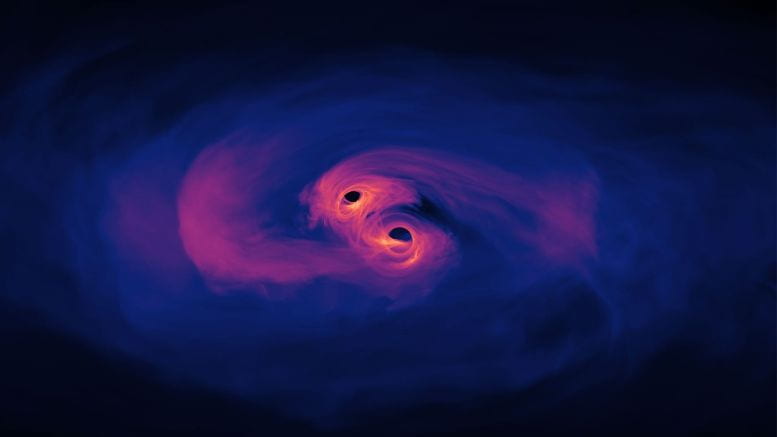Gravitational waves from supermassive black hole binaries might be ‘right around the corner’
June 10, 2023

In a new Northwestern University-led study, astrophysicists crunched 12.5 years of data from 45 dead stars (called pulsars) to set the best limits yet on the gravitational wave signatures emitted from pairs of monster black holes. Knowing these limits will help astrophysicists constrain the number of binaries existing in the nearby universe, confirm or deny existing binary candidates and, someday, detect gravitational waves from these complex pairs.
In another breakthrough, the study also found that when searching for pairs of supermassive black holes, researchers need to account for the steady hum of background noise made by the symphony of gravitational waves from all the supermassive black hole binaries in the universe.
The study was accepted by The Astrophysical Journal Letters and will be published this summer. A preprint of the manuscript is available here.
“We genuinely think that detection of a supermassive black hole binary through gravitational waves is right around the corner,” said Northwestern’s Caitlin Witt, who led the study. “That would be an important discovery for many scientific fields. It would enable us to perform further experiments like testing gravity to explore whether supermassive black hole binaries evolve the way we think they do, and it will teach us how to look for them in future surveys. We also will be able to look back through cosmic time and trace the history of the universe in which we live.”
In 2016, an international team co-led by Northwestern professor Vicky Kalogera used the Laser Interferometer Gravitational-Wave Observatory (LIGO) to first detect gravitational waves from the merger of two stellar-mass black holes, which resulted in obvious, short-lived ripples in space-time. But supermassive black hole binaries are too big and much too far apart for Earth-based equipment like LIGO to detect. These monster pairs create waves so long that it could take years or even decades for their gravitational waves to fully wash over Earth. Even when NASA and the European Space Agency launch LISA (a space-based gravitational-wave detector for which Northwestern professor Shane Larson is a co-principal investigator) in the early 2030s, it still will not be able to detect such enormous waves.
“LIGO can only detect wavelengths that fit within its arms,” Witt said. “We have to look for much lower wave frequencies. We are sensitive to supermassive black hole pairs that can take a month or even up to 15 years to orbit each other. So, we’re looking for a steady signal that could blend into the background.”
Science & Technology

Northwestern accelerates quantum research with NVIDIA technology
September 19, 2025
NVIDIA code could help researchers tackle computationally demanding tasks hindering quantum research Northwestern University physicists are using NVIDIA technology to tackle the computationally demanding tasks hindering quantum research. Northwestern theoretical physicist Jens Koch and his research group…

CRISPR’s efficiency triples with DNA-wrapped nanoparticles
September 18, 2025
New system delivers CRISPR machinery more safely and effectively into cells With the power to rewrite the genetic code underlying countless diseases, CRISPR holds immense promise to revolutionize medicine. But until scientists can deliver its…

Passion for the planet: A new generation of environmental stewards starts here
May 29, 2025
Over the last two decades, the Weinberg College-housed Program in Environmental Policy and Culture (EPC) at Northwestern has embraced the humanities and social sciences and cultivated a new generation of environmental stewards. Growing up in…

Northwestern receives $25 million gift to advance adolescent mental health research
May 16, 2025
New institute will study psychology of emerging adults, leading to innovative wellness programming for students at the University and beyond Northwestern University is launching the Institute for Adolescent Mental Health and Well-Being, an interdisciplinary initiative…



